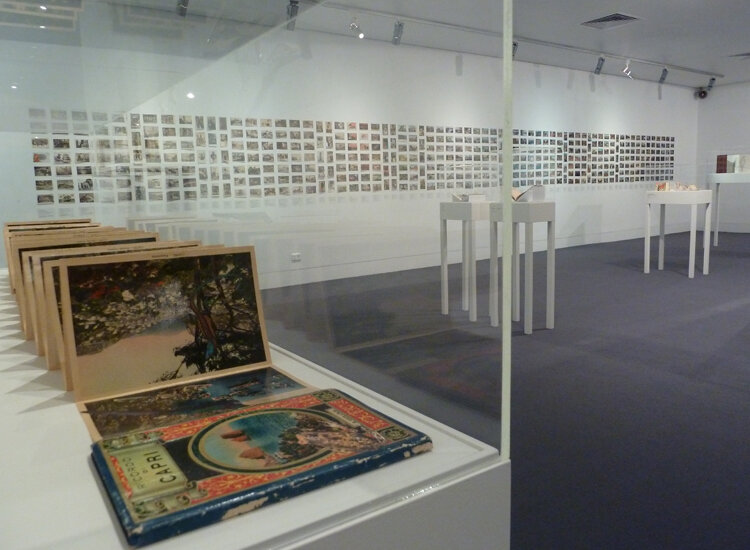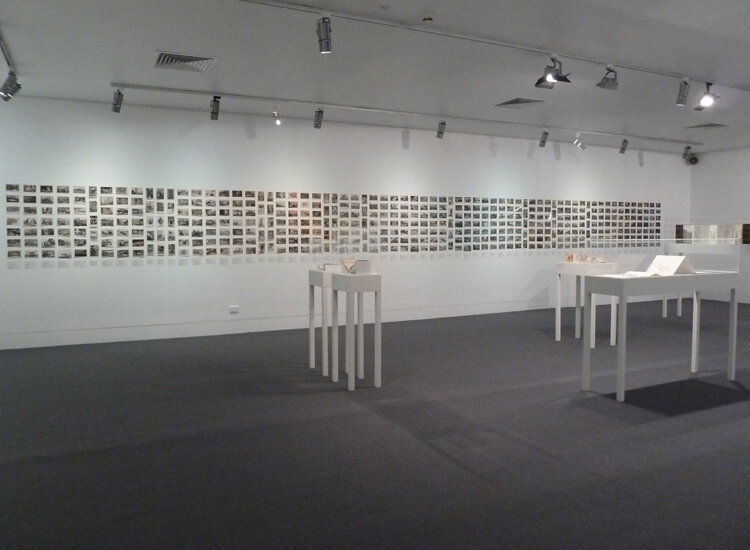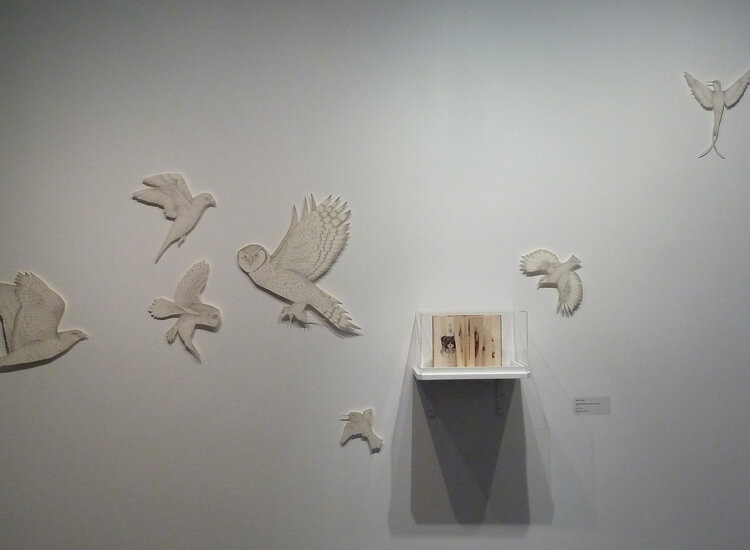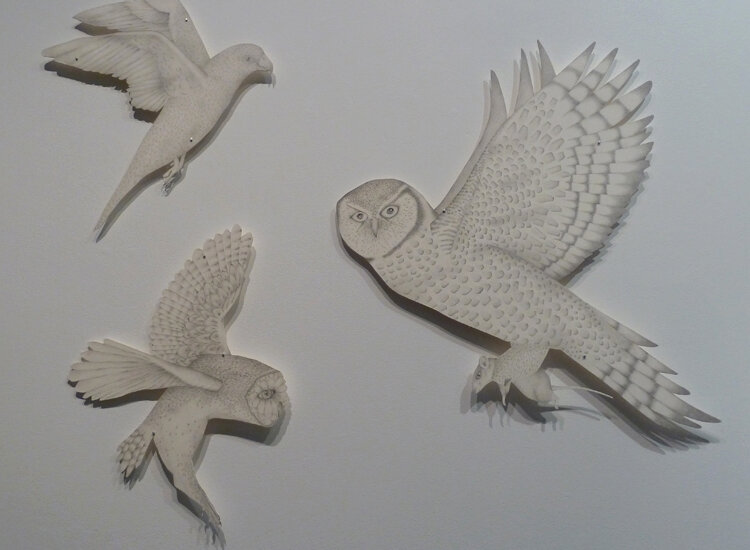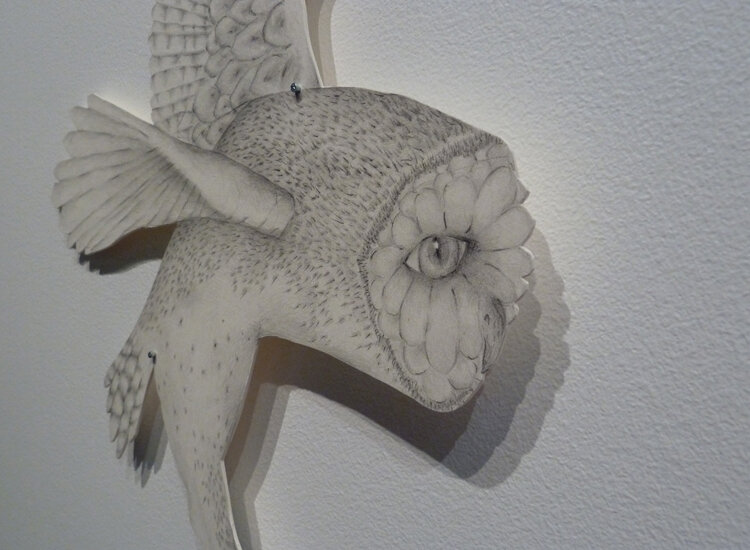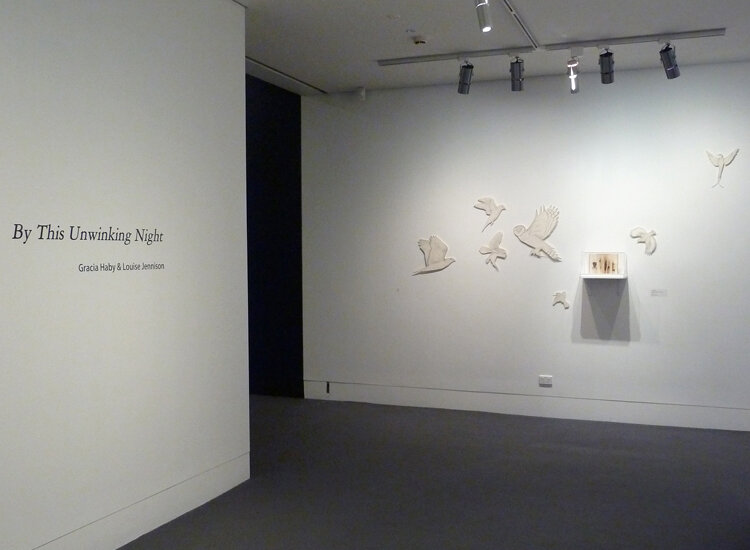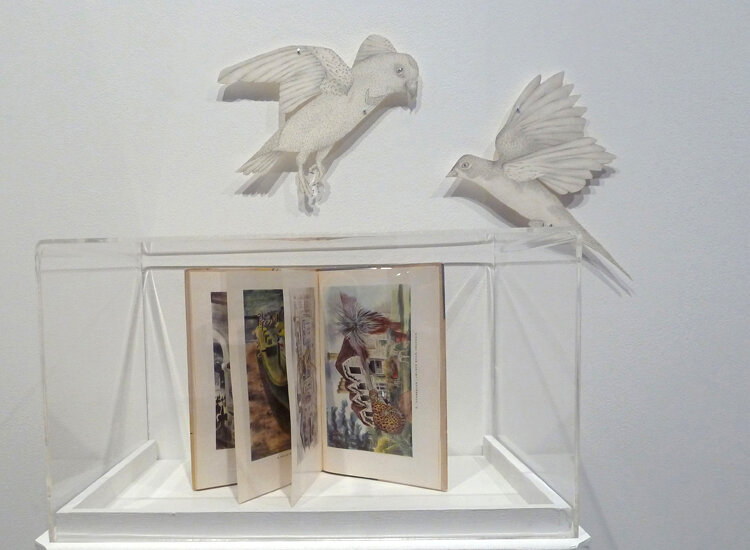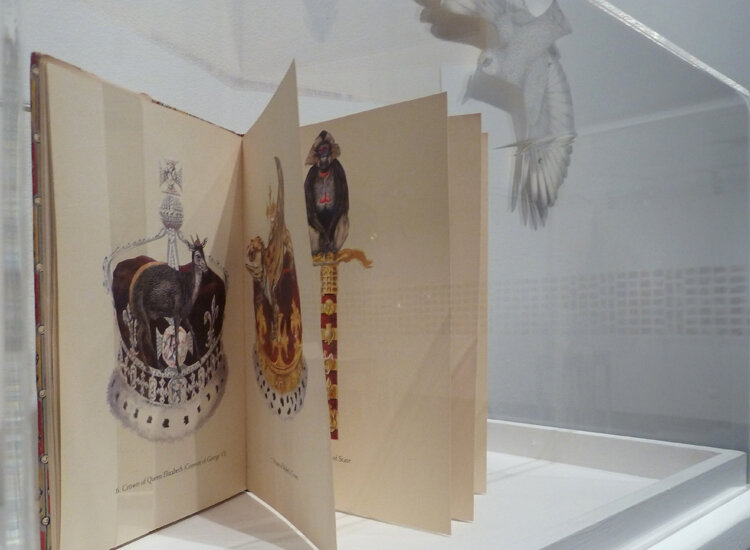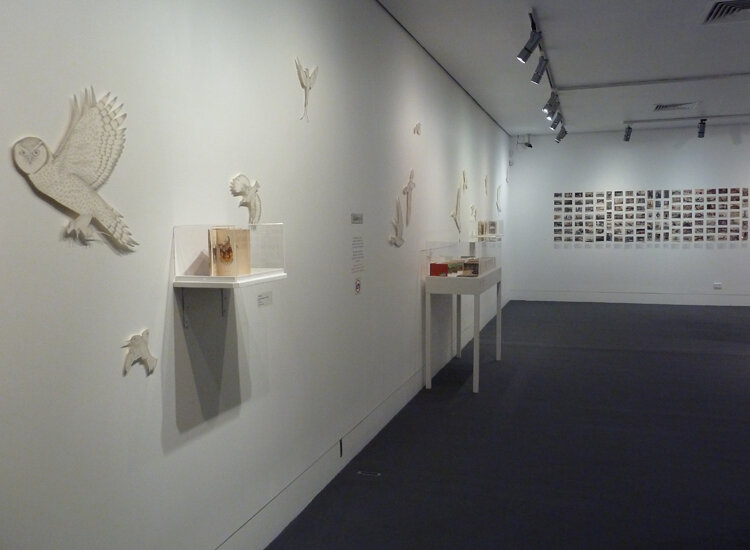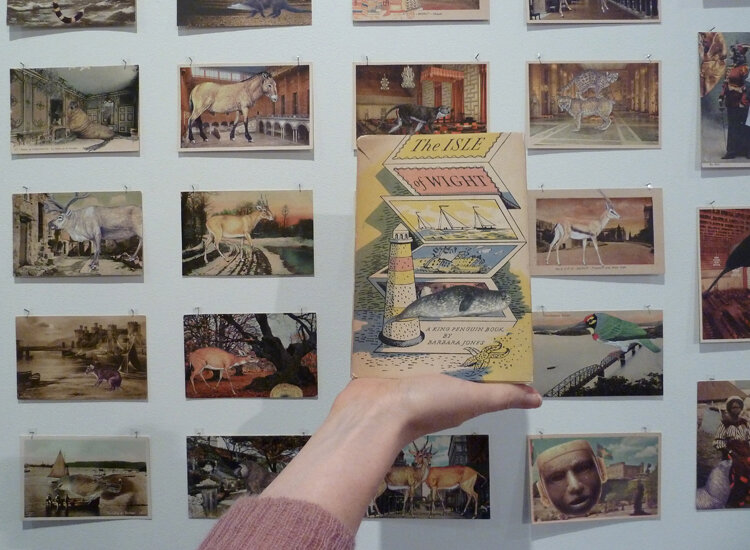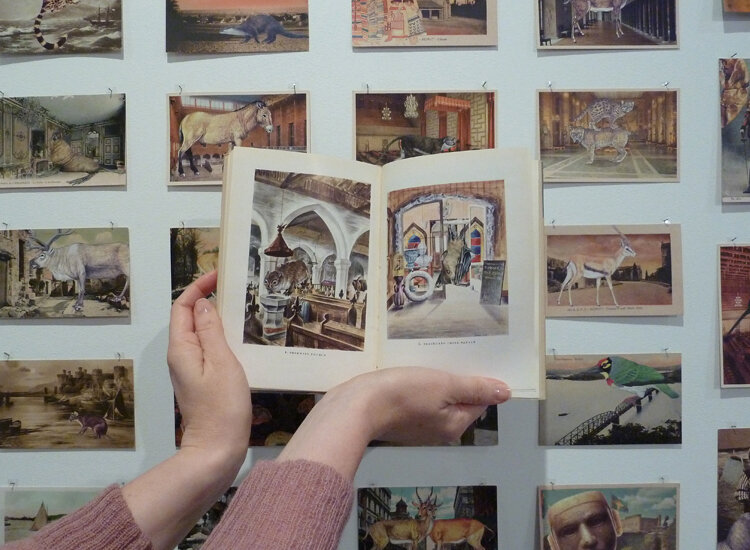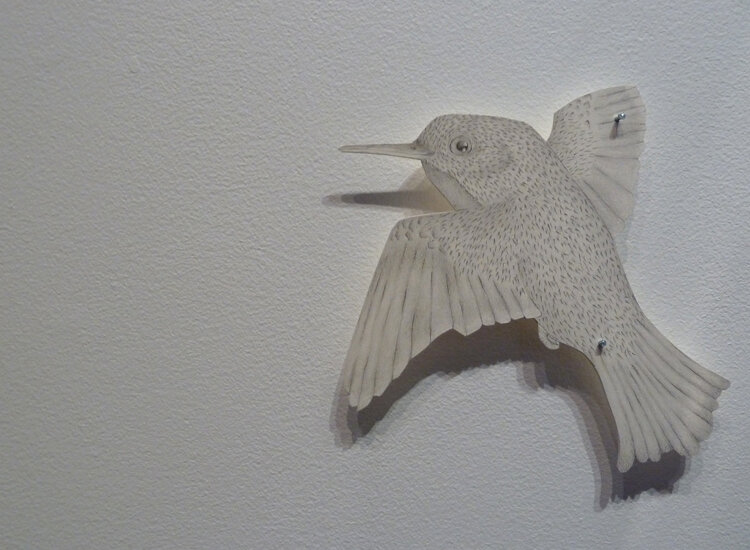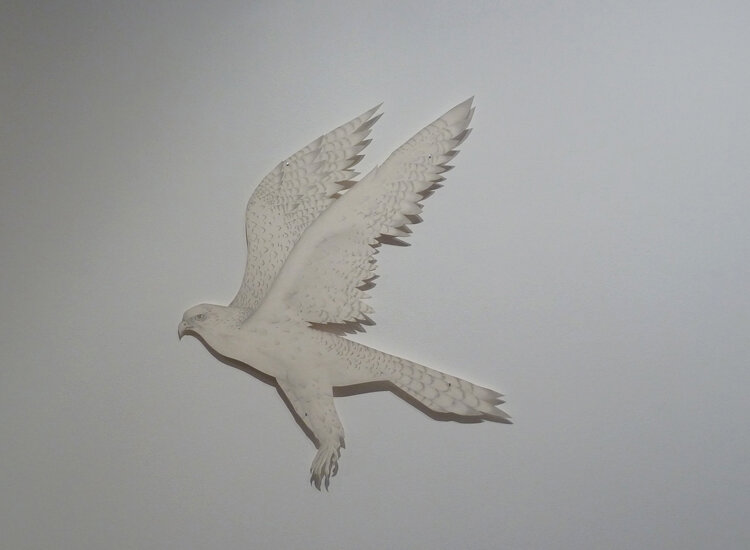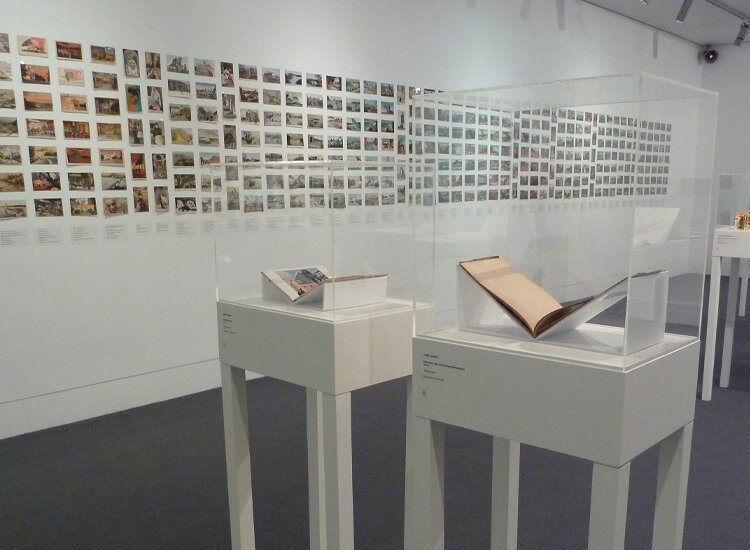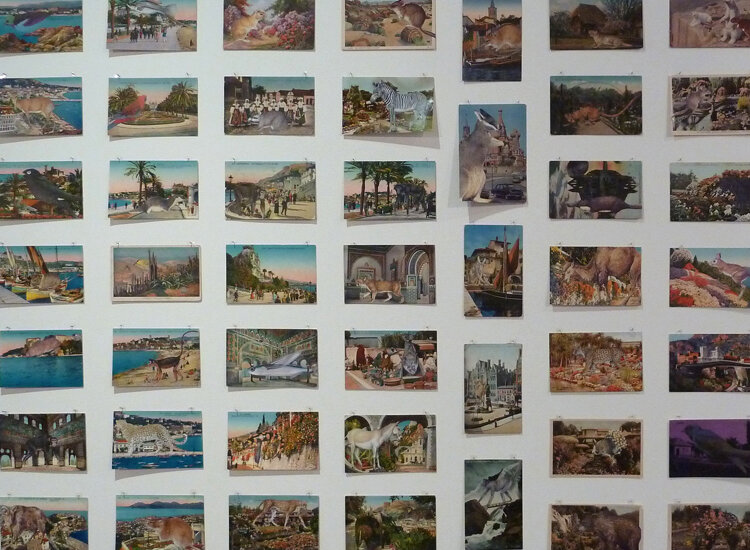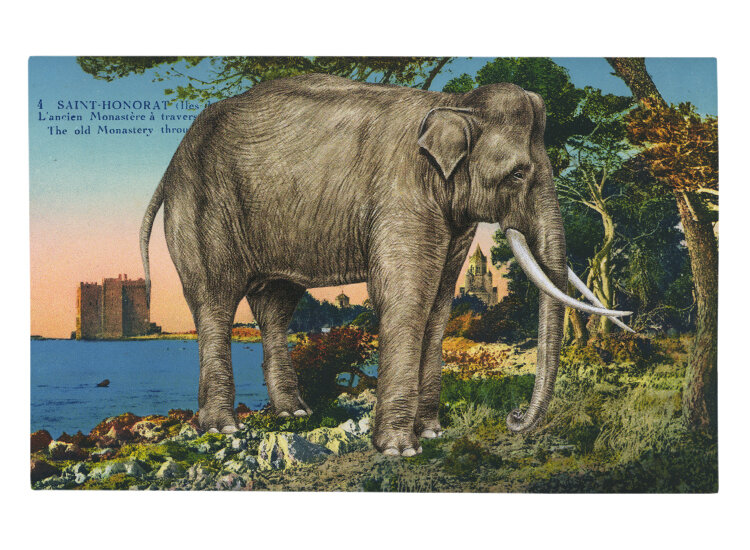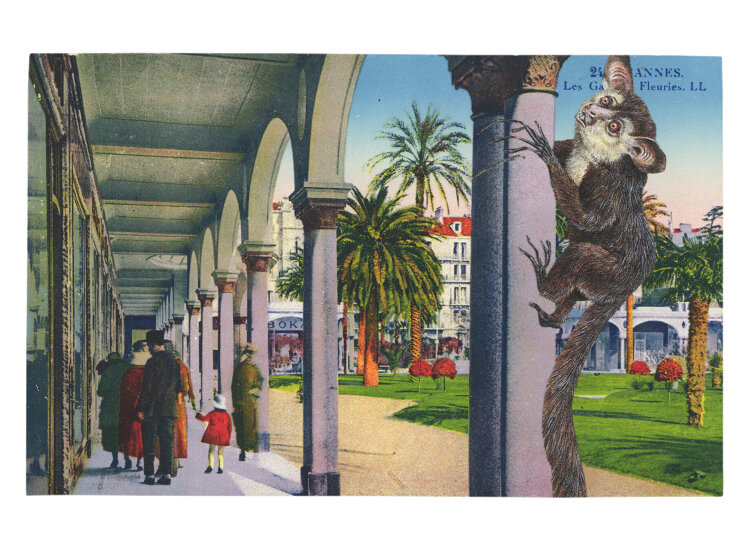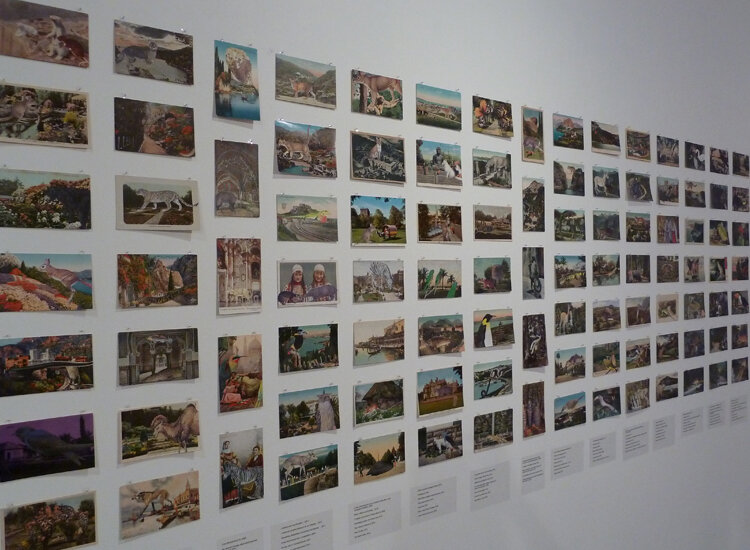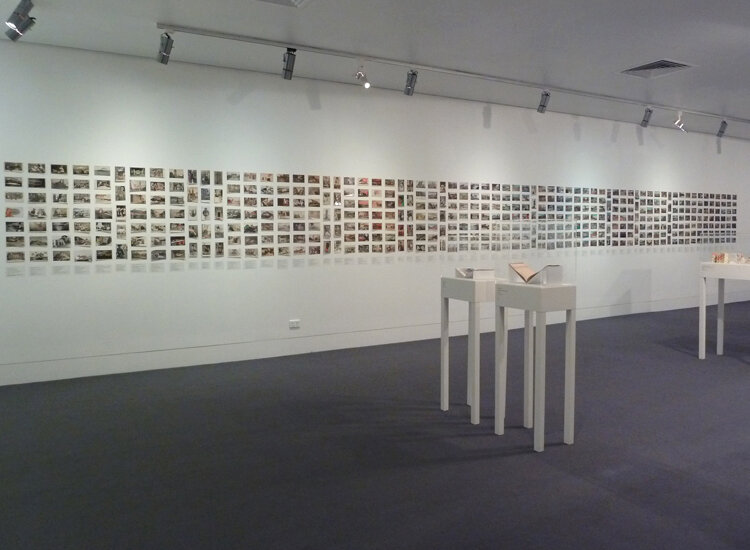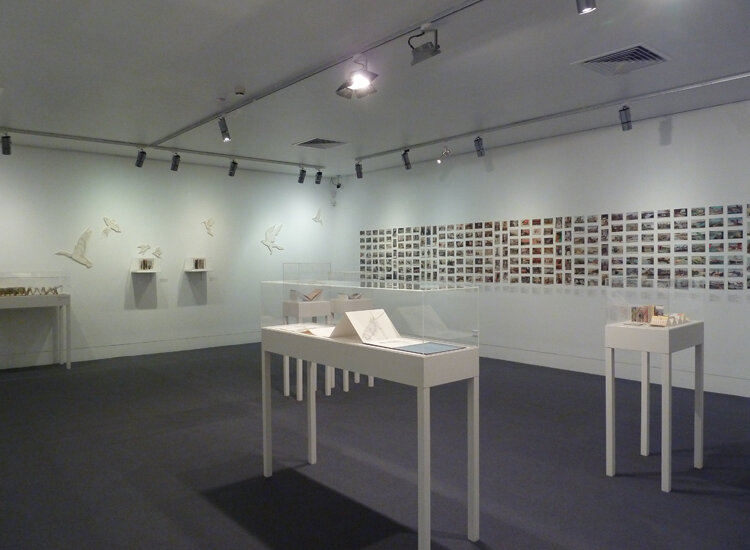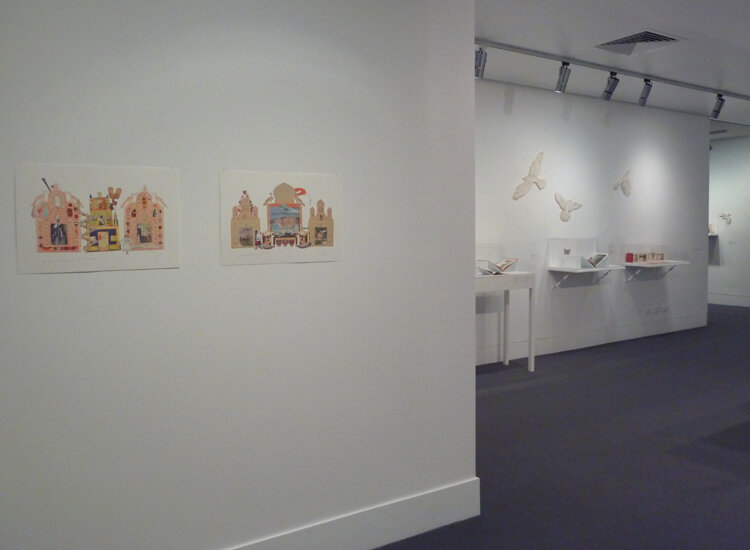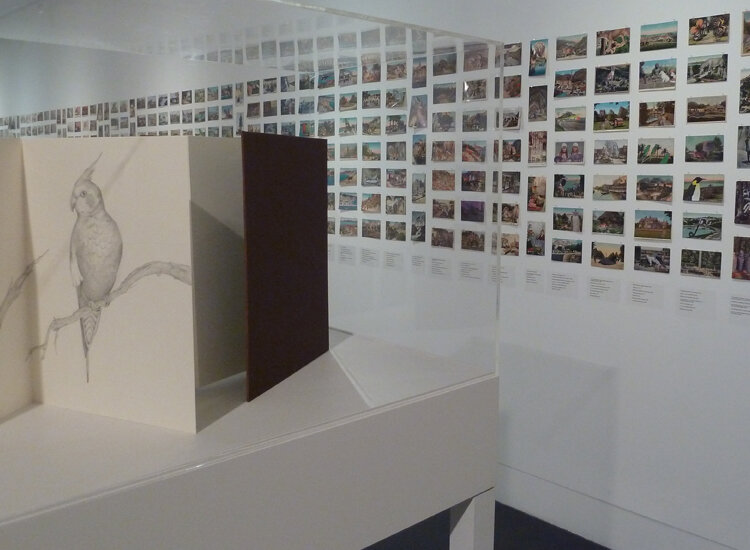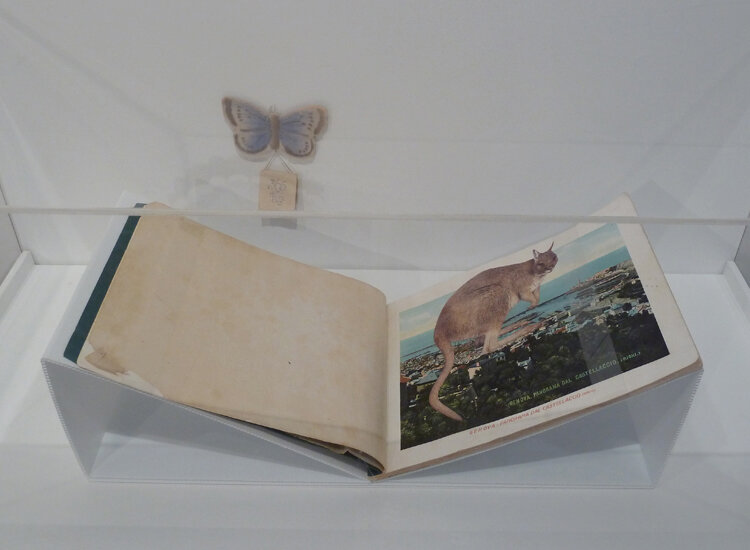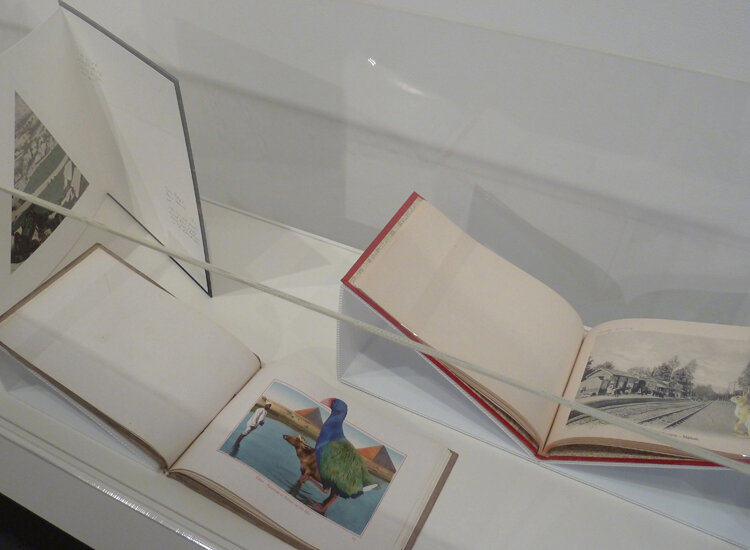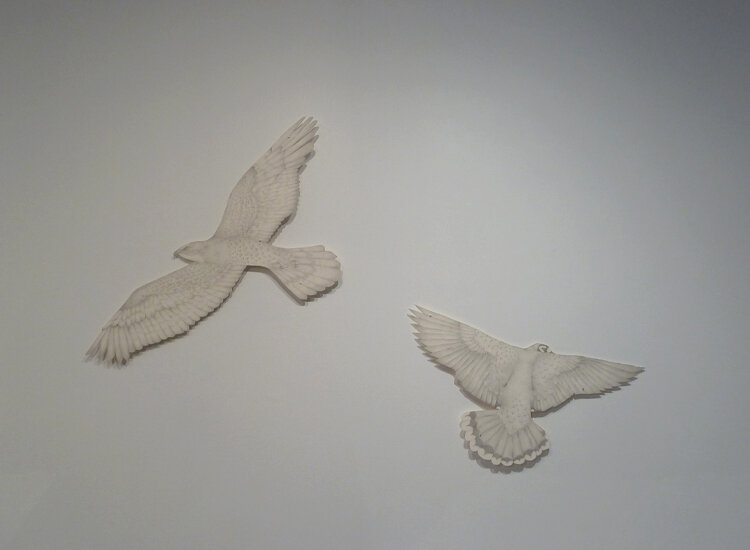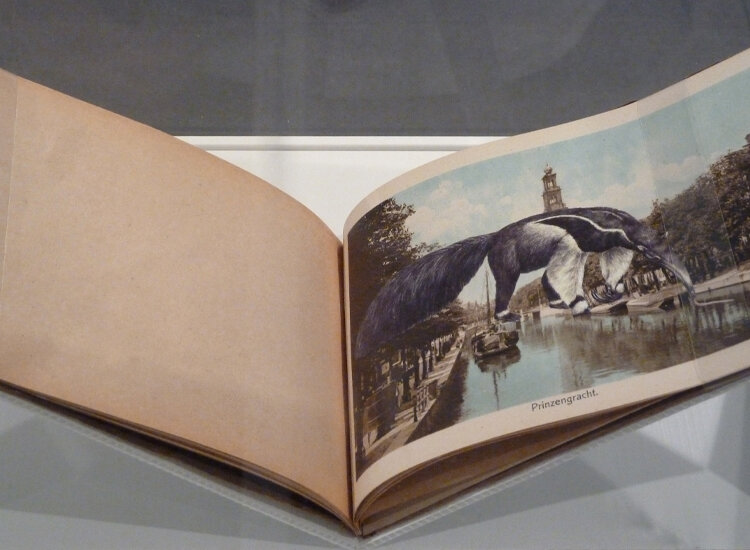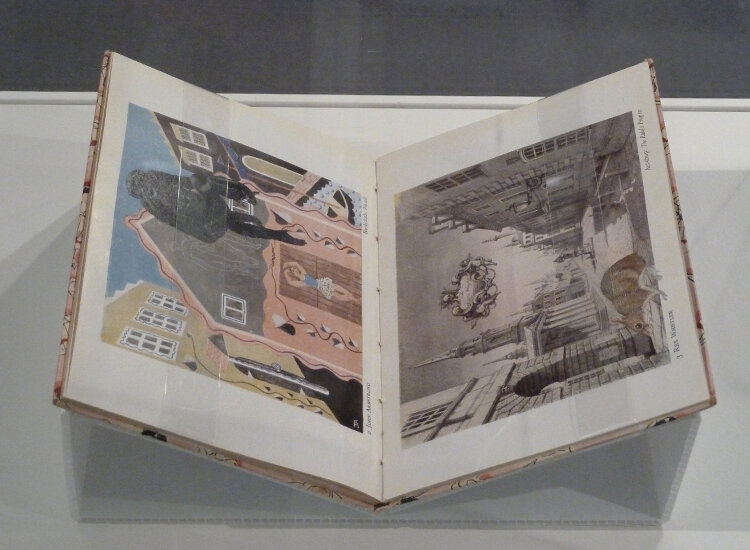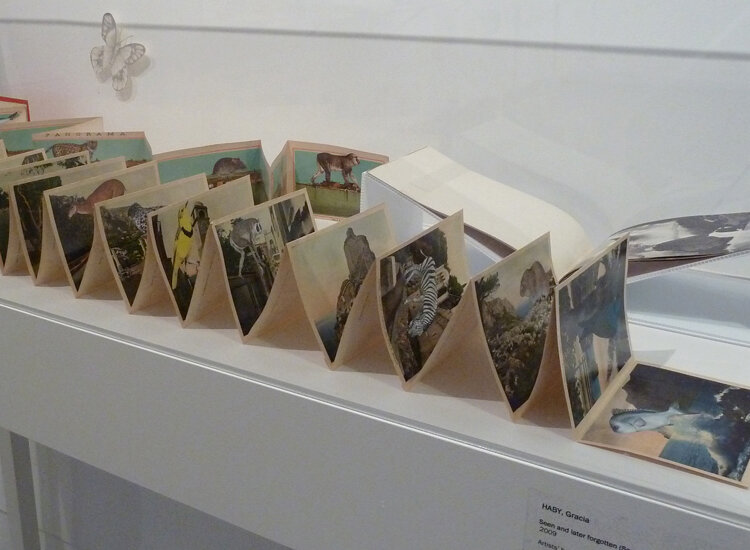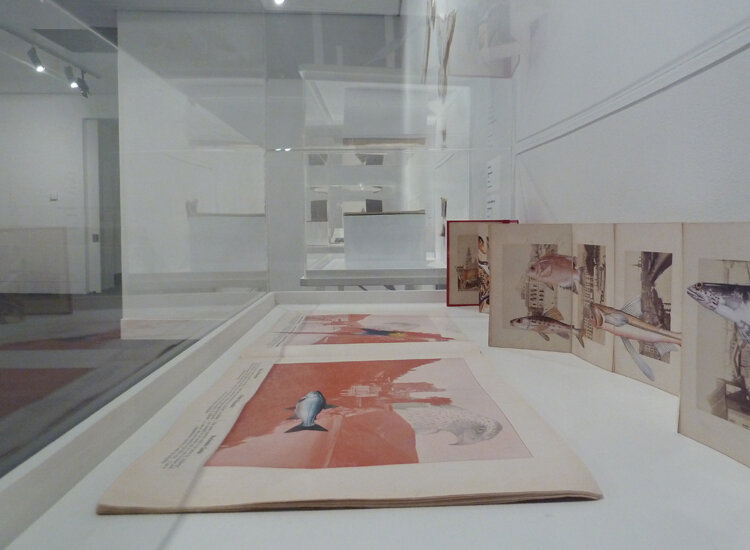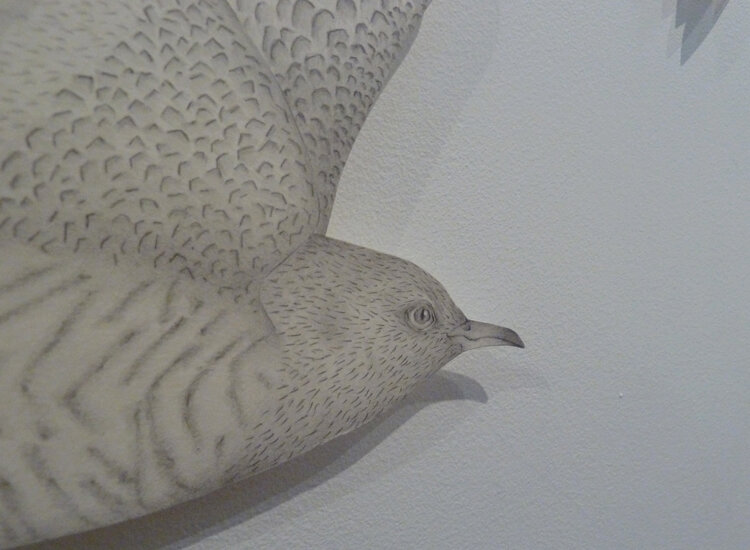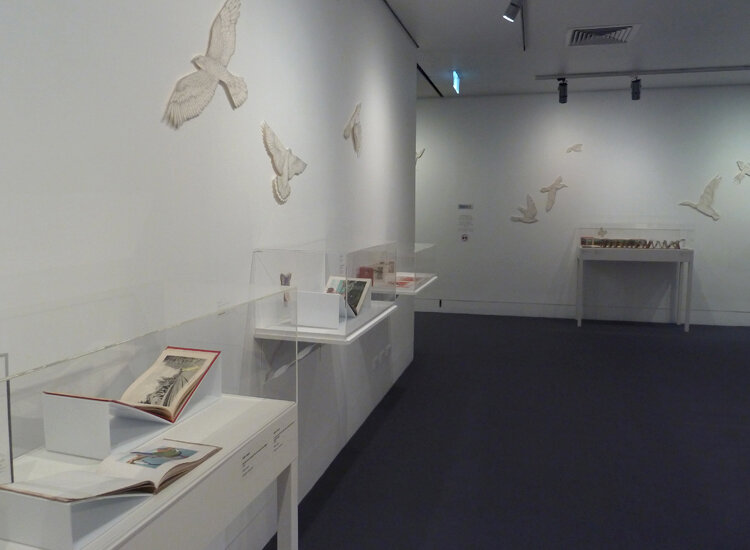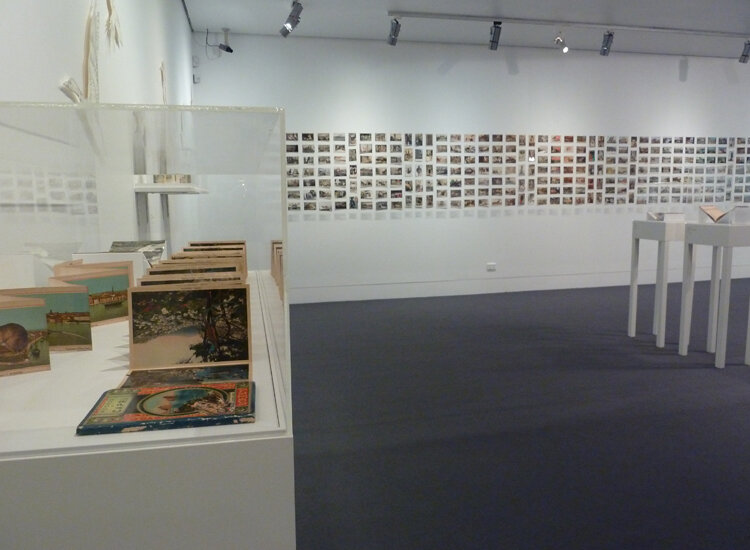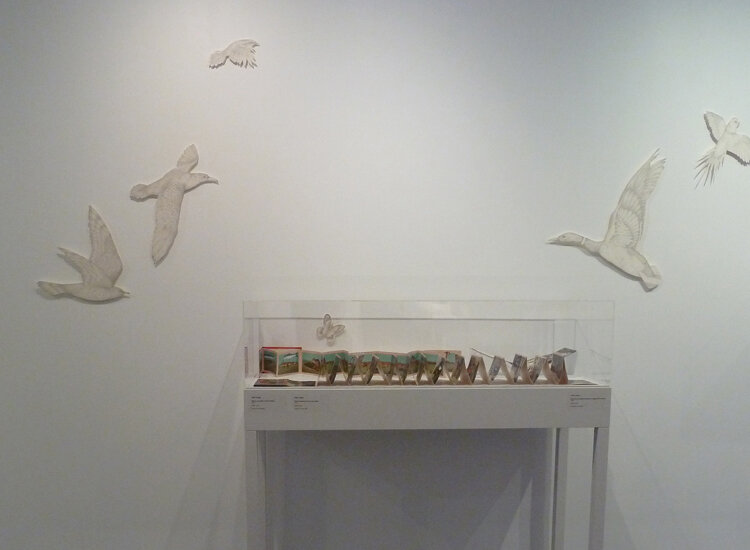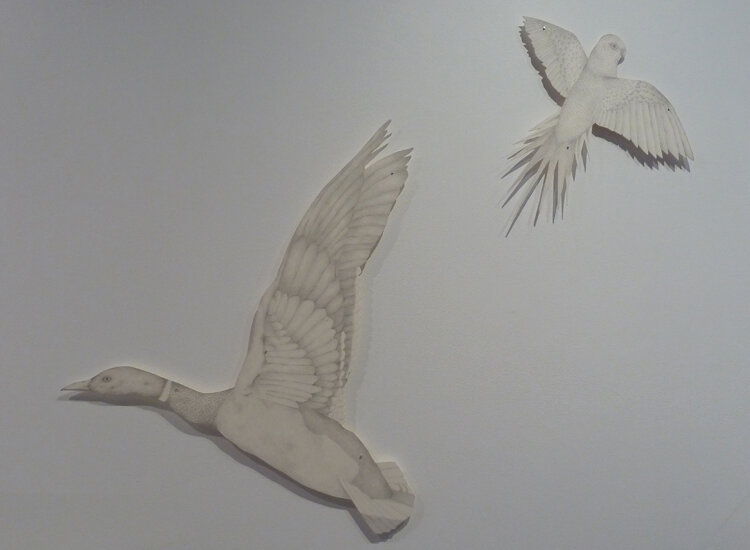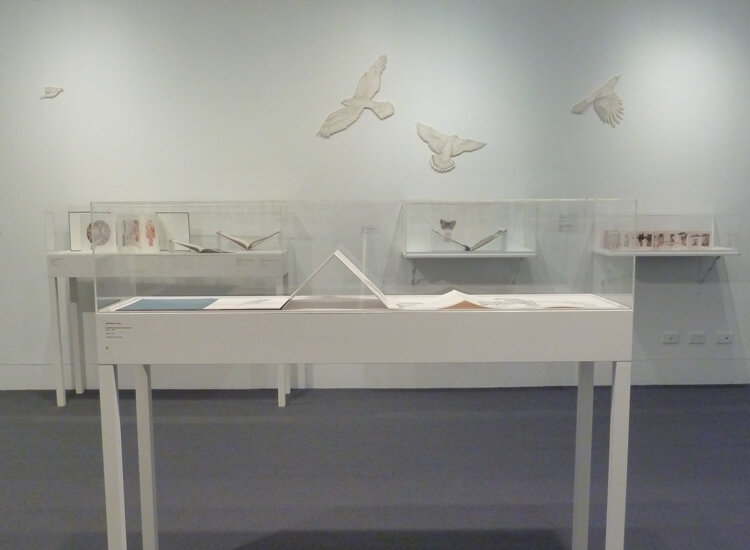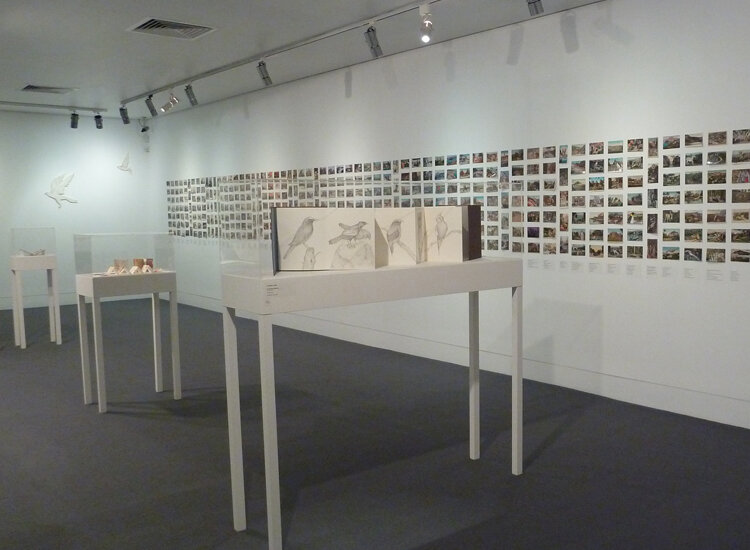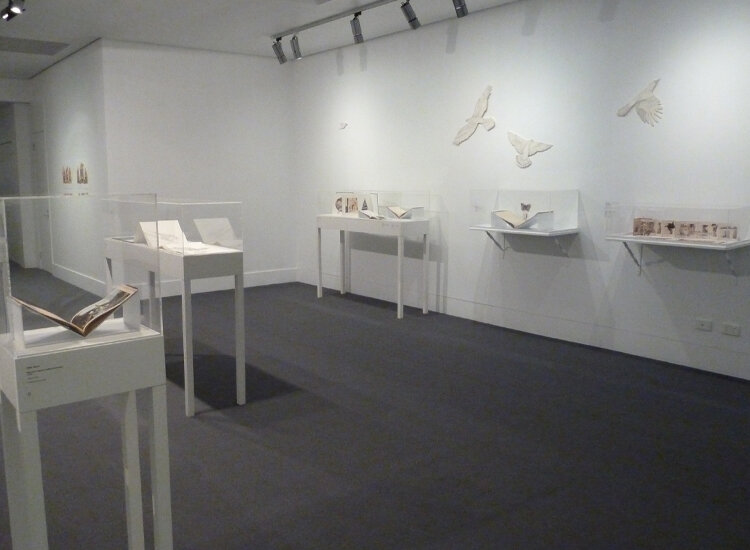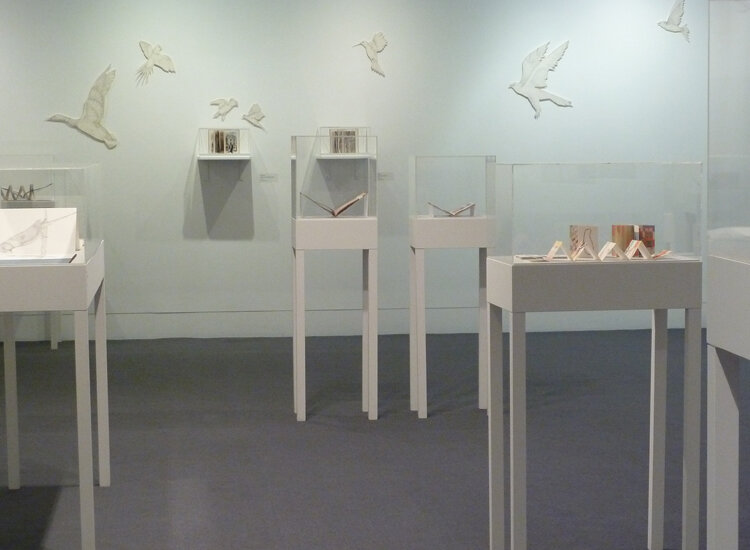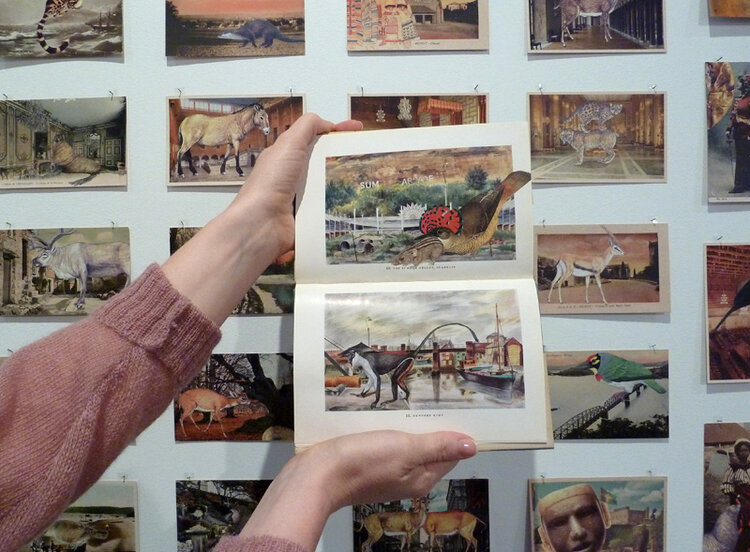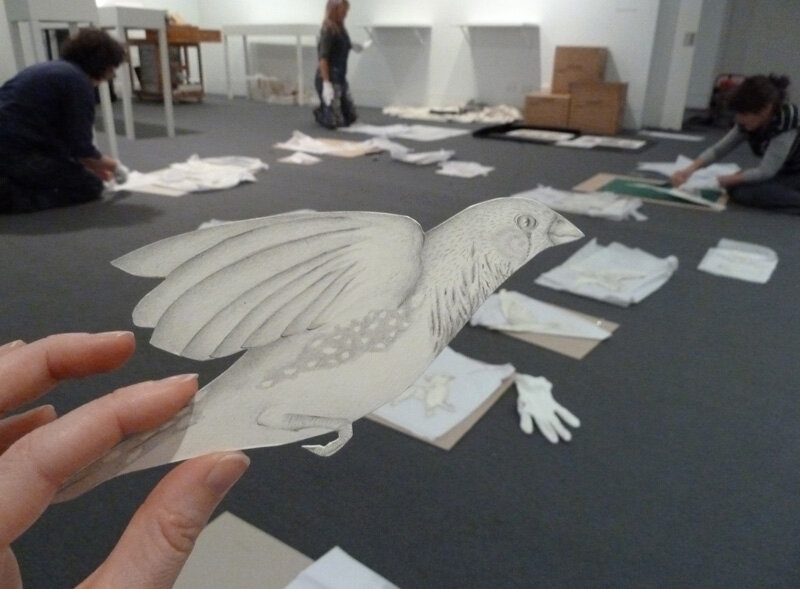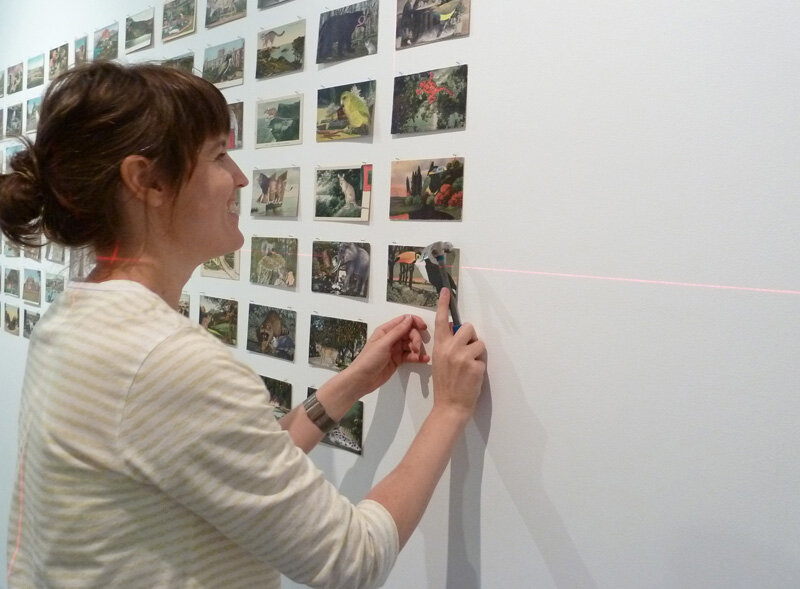BY THIS UNWINKING NIGHT
“Bringing together collage, drawing and photography, the exhibition reveals the artists’ shared interest in the intersection between the animal and the human worlds.”
Gracia Haby & Louise Jennison
By This Unwinking Night
2012
Saturday 4th of February – Sunday 1st of April, 2012
Latrobe Regional Gallery, 138 Commercial Road, Morwell (Victoria)
Dear you,
We’ve borrowed a line from J. Milton and assembled beneath it a gathering of works on paper new, recent, and near-to forgotten. We are using it as the roof to our shelter. Prints, artists’ books, collage, drawings, and small publications laid out for you By This Unwinking Night.
Yours in paper covered,
Gracia & Louise
A small note: “By this unwinking night” features in the translation of 17th-century English poet John Milton's sonnet, On His Blindness, from French back into English in Georges Perec's novel A Void (La Disparition). Written in the French language in 1969, La Disparition is a lipogram in which no letter E appears. It was translated from the French into English in 1994, still deliciously deprived of an E, by Gilbert Adair. Thus, Milton’s On His Blindness becomes On His Glaucoma in our Vintage Classics translation published in 2008. This game reminiscent of Chinese Whispers amuses us and seems a rich ground to pitch our tent.
A photographic (tumbling) tour of By This Unwinking Night (created to run in conjunction with exhibition)
By This Unwinking Night list of works (15 page PDF)
●
We would like to thank all at Latrobe Regional Gallery for their assistance with this exhibition and the marvelous opportunity we’ve relished. Thank- you Julie Adams, Fiona West, and Maria-Luisa Marino. Thank-you Shelley McDermott and Anthea Williams.
We would like to thank all at NETS Victoria for their help and provision of beautiful cabinets in which to house books. Thank-you Georgia Cribb, Emily Jones, and Sherryn Vardy.
We would like to thank Shari Altman, Ria Bauwens, Marieke Berghuis, Des Cowley, Fliss Dodd, Brydie Dyson, Camilla Engman, Elaine & Peter Haby, Alexandra Hedberg, Susan & John Jennison, Olivia Meehan, Susan Millard, Kristi Moore, and Francesca Sasnaitis, for the original postcards they have sent our way over the years which are now included on the gallery wall with new additions, be they tailed or furred.
We would like to thank, too, our dear families and dear friends, for their post on which to lean and their ears and hearts lent. We would like to thank you, the visitor, for taking a look at the things we have been working on and take delight in sharing with you, and we wish you well as you weave your path through galleries four and five, meeting the cast of characters we have assembled.
﹏
RELATED POSTS,
WHAT GOES UP...
...COMES DOWN
DONE AND DUSTED, WELL AND TRULY
"HE WENT TO THE FURTHEST REACHES OF THE EARTH IN HIS QUEST FOR THE PUREST SPECIMEN OF BEAUTY. AND WHEN HE FOUND IT, HE STUCK A PIN THROUGH ITS HEART."
SPEAKING, NATTERING, CHATTERING
WE ARE TWO CHATTERBOXES
CLICK. CLICK. WINK. WINK.
UNWINKING
YOU'RE INVITED
IN A SERIES OF FLYING LEAPS
FEATHERS IN PLACE AND GOATS ON THE LOOSE
THIS GALLERY IS NO LONGER CLOSED FOR INSTALLATION
THE WINGED SHIMMY
THE INSTALLATION LIMBER
(An introduction to) By This Unwinking Night
Fiona West, Senior Curator Latrobe Regional Gallery
2012
The world of Gracia & Louise is an elaborate fairytale that transcends all logic of time and truth. Images bounce from past to recent, reality to fiction and come together in a perfectly constructed world, rich in narrative and wonder.
Gracia Haby and Louise Jennison draw inspiration from vintage postcards, old books and wildlife illustrations to create surreal realities in the the form of prints, books, collages and zines. The artists combine incongruous elements from this source material to stage these spectacles, with animals playing the main protagonists. The presence of the animal is fundamental in their work as it is used to express “our very behaviour, those moral principles one governs the self by, and to explore the relationship with the natural world”.
The Craft Blog: A blog on art, craft and design presented by Craft Victoria
Ramona Barry
handmadelife
20th August, 2012
Life and nature spark as the universe turns upside-down and inside out transforming itself into something that is colourful, yet subtle, weightless, yet bold, enchantingly dreamlike, yet so very real. It is By This Unwinking Night by no other than the collage and illustrative masters Gracia Haby and Louise Jennison. The title has been borrowed from the translation of John Milton’s sonnet, the 17th Century English poet, On His Blindness and with that the exhibition follows suit with it’s ethereal ambiance and dexterous execution.
The exhibition is currently showing at Latrobe Regional Gallery (138 Commercial Road, Morwell) and will continue to until Sunday 1 April 2012. If the trek is truly unobtainable, as it is most definitely worth the trip, the girls have generously created a tumbling walk through of the exhibition here for their visitors and admirers of the virtual variety.
A couple of questions answered
25th April, 2012
Natalie, a student from the University of Ballarat, sent the following questions to us.
How did you first become interested in your work?
No clear start can either of us recall. It feels to each of us as though we have always been interested in making our work, in working with our hands, in drawing that which we see around us, in questioning what we see. I can’t recall a beginning for it always was, and if I look through the scrapbooks and photo albums my parents kept throughout my early years, I see that drawing and making was something I have always done and something my parents, too, have always done. Like everyone, drawing and mark making is something that we all do in some way until some of us become discouraged by the perceived inaccuracy of the hand or other pursuits become of greater interest.
In terms of the artists’ books Louise and I make, this sprang chiefly from a bookbinding course in Ascona, Switzerland (thanks to a Freedman Foundation Travelling Scholarship for Emerging Artists in 2002). Previously, we’d each dipped our toes into the bookish waters (working in sketchbooks or modifying through collage those that were found), but it was in Ascona that the world of the book gripped us and held us that little bit closer. We dived in, knowing little, and have been grateful ever since that we did.
What has sustained your work?
Our own interest in making our work essentially sustains it. Nothing is ever finished, there is always something else on the horizon, something you wish to explore. The investigation is never complete if an interest remains, and looking back at earlier works, you always see what you could have done better or differently. This drives you to make more, to keep going. A real love of making, an interest in it, this sustains the work.
On perhaps a more practical note, our work is made possible by the support of loved ones. Some days it feels all too easy to not make or do something, to become disenchanted or to give way to apathy, but the embrace, the support, the cheer squad that is those nearest and dearest reminds you to keep at it.
What is it that you love about what you do?
In short, every little thing. The giddy highs, the crashing lows, the solitude of working, its quietness, the unexpected things that come about through a constant plugging away at it, whatever that ‘it’ may be. There is everything to love about working on a collage, artists’ book, drawing, or other thing yet to take shape. For me, a certain enjoyment is essential to all making. It is also very liberating.
How do you organise exhibitions?
Some exhibitions are ones we have applied for and been successful in our application. Other exhibitions are ones we have been invited to put together, such as our recent exhibition at Latrobe Regional Galley, By This Unwinking Night. We were shown the gallery space available to us and informed of the dates of the show. From there, we took off at a gallop.
We had the gallery floor plan as a guide, on a practical front. The longest wall of the gallery is 13metres. As we work from home, we mapped out 13metres and discovered that this equaled our hallway and lounge room in length (we live in a single storey terrace house). This helped with being able to visualise the space we were making new work for, as the actual gallery is some 2 hours drive from our house. We played around with what was to go on what wall and how, and in the end concluded that a grid of my postcard collages should go on this wall. For this one wall, we figured out how many columns of postcard collages would fit on the wall and how many rows, keeping in mind that most were horizontal. Working from the left, the postcards begin in black and white. This leads into sepia before giving way to golden highlights and rose. Light blues follow, and the seascape comes to the fore. From here, near to the mid point, brighter colour splashes appear and the works (postcards from Spain, Monte Carlo and Cannes) give us pinks, blues and sunlight. This is followed on the heels by green, mountains and various interiors before nightfall and midnight inkiness. This pattern, this arrangement 11metres in length, it was organized on two large drawing boards. I need not tell you that the details of this took an age, but it was a fun challenge to meet. How each collage related to not only that which sat above and below but to its left and right had to be considered. This is but one part of an exhibition, but it will perhaps give you an idea of the things that happen in the background. With any exhibition we do, we like to try to do as much as possible before the installation process begins. We like to iron out any quirks and particulars; it serves as a working drawing before a painting. Organisation helps you face the unexpected things that naturally crop up.
Cabinets for the show were sourced and provided by the wonderful NETS Victoria. We loaned six cabinets in total, and this meant that we could display our artists’ books securely. Had we not of been able to borrow these, we would have had to rethink our plans for the exhibition. Organising an exhibition and its installation is something we both love. It takes many forms before it finally settles and, of course, it leaves you wanting to do it all again.
What are your most challenging aspects of your work?
One of the most challenging aspects would be finding new spaces or, indeed, any space to exhibit our work. The ideas, the actual making of work, this is for us at this moment not where the greatest challenge lies, or if it is, it is one we so relish that we don’t think of it as a challenge.
Now that our show is no longer at Latrobe Regional Gallery, we are working towards shaping what comes next. We are putting in grant applications and exhibition proposals and keeping our fingers crossed. Whittling a description for a proposed new body of work down to 100 characters is a challenge. Dusting yourself off and starting again in the face of scores of inevitable rejections is also a challenge.
In terms of our artistic practice, not repeating yourself, too, can be a challenge. Coming up with new things can be a challenge, if you find yourself in a rut. Gluing collage pieces in place on a hot day and finding the glue dries too quickly, too lumpy, why, this can be a challenge. As with anything, I guess it is just how you look at it at the time.
Do you or did you have mentors?
Of course. Many lecturers and curators we have been fortunate enough to study under or work with. We have enjoyed working with various people, from printers to bookbinders, when making our artists’ books, and their advice and patience has been invaluable. Add to that long list, librarians, book experts, and the good folk at Craft Victoria and NETS Victoria for their boundless knowledge and enthusiasm.
Have you ever had to deal with copyright issues?
The images we use within collages we make collaboratively, or that I make independently, are often out of copyright or have been altered in such a way that they are removed from existing source. If another artists’ work were to feature within, we would credit this or refer to it. My piece for Of Birds and Fishes, From this bed, with the wings of a bird, I flew to the sea as I slept last night, for example, features owls, ducks and fish of all sizes that swim and leap their way through a theatre set by the painter Paul Nash. The set was created for a one-act play, The Truth About the Russian Dancers, written especially for the dancer Tamara Karsavina by J. M. Barrie. The play was first performed in 1920 at the London Colosseum. At the Savoy some six years later, the play was revived, and now it forms the backdrop to a collage. The history of this sourced image is important to me and informs how the image is incorporated.
Do you have a contract with your gallery?
Whilst we are exhibiting a body of work, we have a contract with the gallery. This outlines what our responsibilities are and what their responsibilities are. This is only for the duration of the show and they are standard, covering insurance of artwork, freight responsibilities (if applicable), artists' fees (again, if applicable), and other costs related to the exhibition.
What's the benefit if you have a contract?
A contract with the gallery is not negotiable, and it outlines clearly for the benefit of all parties involved (both gallery and artist) what their responsibilities are. As a gallery does not represent us, we only have a contract for the duration of an exhibition.
Do you ever require contract or permission release forms?
We often have to sign forms to give publications and institutions permission to reproduce an image of our work and happily do so. Recently, the State Library of Victoria used a detail of our work within their Fine Impressions: printmaking and artists' books in Melbourne 1999–2010 catalogue and their SLV News publication, and Melbourne University Library used a detail from our artists’ book Sleeping During the Day on their Christmas cards (2011).
Where do you get your inspirations from?
Everything and anything. To me, it is not where you necessarily find your inspiration that is important, but merely that you find it and in turn use it in some way eventually. As I find myself often writing in my feedback to my students who study painting (Exploring Painting at RMIT through Open Universities) and thus may sound like a broken record, you could find inspiration for a composition in the palette of a film recently seen or in the colours of the clothing of someone you pass on the street. It is not always important the source, namely that you find it and recognise it.
Many things are inspiring to us. Classical music is inspiring, from Shostakovich and Stravinsky to Riccardo Eugenio Drigo and Hayden. All music is inspiring. Literature is inspiring and our home is lined with books. Gardening frees up the mind, offering time to reflect and thus is inspiring. Travel and film, performance and nature, they, too, give up inspiration freely. Really, everything is inspiring, anything can impart a truth or spark an idea. The trick is to remain open to them.
Does your work have any hidden meaning?
Yes. Our use of the ever-present animal within our work is there part as decorative lure. Hard to miss, the animal runs up hills, scales rooftops, performs cartwheels, and passes through a scene new or more familiar. For us, the animal is there to question our very behaviour, those moral principles one governs the self by, and to explore the relationship with the natural world. It is not really a hidden meaning, but it is what we are interested in exploring through our work at the moment. It is up to you to see what you wish to see. You can see riddles to unravel; you could stumble across the unexpected. You could find the scene amusing, and we like to keep in mind that “the longer and more carefully we look at a funny story, the sadder it becomes”, as Nikolai Gogol wrote.
Do you have a favourite artist?
Happily, too many to list. No one favourite artist, be it in the visual arts or otherwise, for either of us, I’m afraid. Perhaps it is easier to say that we are looking forward to seeing William Kentridge: Five Themes at ACMI (before it closes on the 27th of May), and Napoleon: Revolution to Empire at the NGV (opening the 2nd of June). Perhaps, too, it is easier to say that we enjoy seeing the new work made with image or words by our friends we have meet through blogging: Lisa Solomon, Camilla Engman, Alexandra Hedberg, Hila Shachar, Anna Emilia, Denise Parsons, and others.
And on our bookshelves, there are books featuring the work of Kiki Smith, Edvard Munch, Paul Klee, Malevich, Eva Hesse, the Ballet Russes, Joseph Beuys, Max Ernst, Dieter Roth, Joseph Cornell, Christian Schad, Louise Bourgeois, and Ernst Ludwig Kirchner. There are novels by Tolstoy, Orhan Pamuk, Robert Walser, Emily Brontë, Wodehouse, Herta Müller, Gail Jones....
All inspirational.
Have you any special places where you source your materials?
Yes, and they are all secret, I’m afraid. In addition, though, we are often sent postcards and ephemera to make use of and for this we are most grateful.
Do you use Photoshop and/or cut and paste with your collage?
Both. The postcard collages, as medium suggests, are all made by hand with a pair of sharp scissors and glue and the aid of a strong light source. Other pieces, namely our collaborative collages, are created using Photoshop but are built largely the same way through layering. The only difference is the off cuts digitally we have not so far found a use for (unlike when working with paper). Images are scanned large to ensure versatility and this means that we can widen the scope of our source material. They are both enjoyable ways of working though quite different.
Gracia Haby
For Natalie, High Up in the Trees
